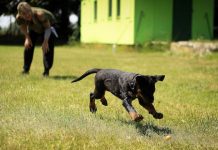1.Canned food (8-15% protein), 2-15% fat,75%moisture,375-950 ME/Kcal/ lb.
1. Dry matter intake is ghigh due to low caloric content.
2. Highest palatability
3. Highest cost/ serving
4. Less convenient to serve
5. Needs refrigeration
2.Dry diet (18-27% protein, 7-15% fat less than 12% moisture, 35-50%carbohydrate and 1400-2000 ME/Kcal /lb.
1. Dry diets were introduced in 1890 where it was given as baked biscuits including grain, vegetables meat and is continued to be widely used form.
2. Generally are crunchy. Dogs relish feeding when moistened.
3. Reduce tartar and tooth decay.
4. Easy to store
5. Convenient economical
3.Soft moist (16-25% protein, 5-10% fat, 25-35% carbohydrates 30%moisture 1200-1350ME/Kcal/lb
1. Easy to store and serve
2. Expensive with regard to intake as it is low in caloric content
Other criteria in selecting food are cost, Nutrient density, Palatability,Digestability/ stool volume and Availability.
Feeding Adult Dogs
Normally active adult dogs with no weight problems can be fed good quality of commercial diet, which is “Commercially complete and balanced for all life stages”
Some adult dogs may not have high caloric needs and hence should be fed with low caloric diets having less fat and sodium. Feeding should be at least once in a day, to the extent of twice a day for large active breed. Fresh drinking water should be made available.
Feeding Pregnant Dogs
Usually nutritional hike is not required up to 5-6 weeks, the requirement for the last 2-3 weeks of pregnancy is increased and diet with at least 1600Mcal/lb. Food with 215 proteins is recommended.
Feeding Lactating Dogs
The requirement for lactation continues to increase till the 4th week. Moistening dry food with water will encourage food intake during lactation. From 3-4 weeks puppies will start nibbling solid food. From 6-8weeks only less than 50% above maintenance requirement is needed.
Feeding on the Day of Weaning
The bitch should not receive food on the day but should have plenty of water. On the day after weaning, dam should receive ¼ th the amount, which was fed prior to being bred. The dam and puppies can be grouped together for few hours on the day so that the pups can nurse the dam dry. On third day, half the quantity of maintenance and 3/4th on the fourth day and usual maintenance diet is recommended from 5 th day onwards.
Feeding Puppies
Puppy in a litter should gain approximately its birth weight in each week during lactation and nursing period. The typical introduction of a puppy to solid food (Around 3-4 weeks of age) usually amounts to the pup romping around and through the dams food bowls, licking moistened dry food from its paws. A dry puppy food should b e fed, moistened during first few weeks after weaning to encourage adequate food intake. Mixing one part of warm water to 3 parts of dry puppy food will make the food tastier and easier for puppy to eat. The feeding time should not be more than one hour.
Development of pet food
Each pet food manufacture has his own procedure for develop new product or modifying the current brand, this can be based on market research or a diet concept.
The owners preferences like cost satisfaction, reputation, storage capacity and convenience and pets preferences like ingredients, nutritional content palatability factors like colour, texture shape and other physical characters as well as mouthful level of cooking are considered in the development of a pet food.
The nutritional assessment of pet foods are done by digestibility and metabolic trails of products intended for meeting the requirement for various life stage or as per the claims used in the product
Disclaimer
Please do not attempt to use our site to diagnose or treat your pet. Your veterinarian is the best source of health advice; however it is a good idea to be informed so you would know what questions to ask and I hope you find this web site useful.



